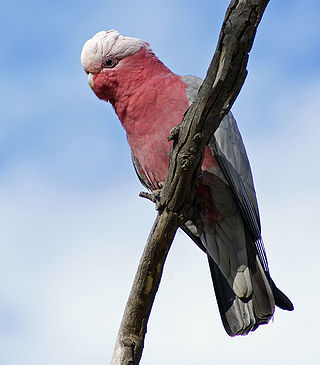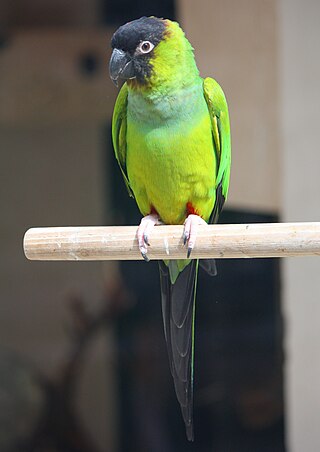
Lovebird is the common name for the genus Agapornis, a small group of parrots in the Old World parrot family Psittaculidae. Of the nine species in the genus, all are native to the African continent, with the grey-headed lovebird being native to the African island of Madagascar.

A cockatoo is any of the 21 species of parrots belonging to the family Cacatuidae, the only family in the superfamily Cacatuoidea. Along with the Psittacoidea and the Strigopoidea, they make up the order Psittaciformes. The family has a mainly Australasian distribution, ranging from the Philippines and the eastern Indonesian islands of Wallacea to New Guinea, the Solomon Islands and Australia.

The cockatiel, also known as the weero/weiro or quarrion, is a medium-sized parrot that is a member of its own branch of the cockatoo family endemic to Australia. They are prized as household pets and companion parrots throughout the world and are relatively easy to breed compared to other parrots. As a caged bird, cockatiels are second in popularity only to the budgerigar.

Wing clipping is the process of trimming a bird's primary wing feathers or remiges so that it is not fully flight-capable, until it moults, sheds the cut feathers and grows new ones.

The galah, less commonly known as the pink and grey cockatoo or rose-breasted cockatoo, is an Australian species of cockatoo and the only member of the genus Eolophus. The galah is adapted to a wide variety of modified and unmodified habitats and is one of Australia's most abundant and widespread bird species. The species is endemic to mainland Australia. It was introduced to Tasmania, where it is now widespread, in the mid-19th century and much more recently to New Zealand.

The scarlet macaw is a large yellow, red and blue Neotropical parrot native to humid evergreen forests of the Americas. Its range extends from southeastern Mexico to Peru, Ecuador, Colombia, Bolivia, Venezuela and Brazil in lowlands of 500 m (1,600 ft) up to 1,000 m (3,300 ft), the Caribbean island of Trinidad, as well as the Pacific island of Coiba. Formerly, the northern extent of its range included southern Tamaulipas. In some areas, it has suffered local extinction because of habitat destruction, or capture for the parrot trade, but in other areas, it remains fairly common. It is the national bird of Honduras. Like its relative the blue-and-yellow macaw, the scarlet macaw is a popular bird in aviculture as a result of its striking plumage.

A companion parrot is a parrot kept as a pet that interacts abundantly with its human counterpart. Generally, most species of parrot can make excellent companions, but must be carefully managed around other common pet species like dogs and cats as they might be hostile towards them.

The red-and-green macaw, also known as the green-winged macaw, is a large, mostly-red macaw of the genus Ara.

The red-bellied macaw, also known as Guacamaya Manilata, is a medium-sized, mostly green parrot, a member of a group of large Neotropical parrots known as macaws. It is the largest of what are commonly called "mini-macaws". The belly has a large maroon patch which gives the species its name.

A parrot harness or bird flight harness is a type of pet harness that is specifically designed to be worn by a parrot.

The red-shouldered macaw is a small green South American parrot, a member of a large group of Neotropical parrots called macaws. The species is named for the red coverts on its wings. It is the smallest macaw, being 30–35 cm (12–14 in) in length - similar in size to the Aratinga parakeets. It is native to the tropical lowlands, savannah, and swamplands of Brazil, the Guianas, Bolivia, Venezuela, and far south-eastern Peru. It has two distinct subspecies, the noble macaw and the Hahn's macaw, and a possible poorly distinct third subspecies that has longer wings, but is otherwise similar to the noble macaw. The Hahn's subspecies is named for German zoologist Carl-Wilhelm Hahn, who in 1834 began compiling Ornithologischer Atlas oder naturgetreue Abbildung und Beschreibung der aussereuropäischen Vögel.

The golden-collared macaw or yellow-collared macaw is a small mostly green Central South American parrot, a member of a large group of Neotropical parrots known as macaws. It has a bright yellow patch on the back of its neck/upper shoulders that gives the species its name. In aviculture, it is one of a number of smaller macaws often called "mini-macaws".

The chestnut-fronted macaw or severe macaw is one of the largest of the mini-macaws. It reaches a size of around 45 cm (18 in) of which around half is the length of the tail.

The white-crowned parrot, also known as the white-crowned pionus in aviculture, is a small parrot which is a resident breeding species ranging from eastern Mexico to western Panama.

The nanday parakeet, also known as the black-hooded parakeet or nanday conure, is a medium-small, mostly green, Neotropical parrot native to continental South America.

The yellow-collared lovebird, also called masked lovebird, black-masked lovebird or eye ring lovebird, is a monotypic species of bird of the lovebird genus in the parrot family Psittaculidae. They are native to Arusha Region of Tanzania and have been introduced to Burundi and Kenya. Although they have been observed in the wild in Puerto Rico, they are probably the result of escaped pets, and no reproduction has been recorded. They have also been observed in Arizona.

The blue-winged macaw, in aviculture more commonly known as Illiger's macaw, is a species of small macaw found in central and eastern South America. The second name is in honor of the German ornithologist Johann Karl Wilhelm Illiger. It was previously placed in the genera Ara or Propyrrhura. Blue-winged macaws have been known to reach an age of 50–60 years.

A parrot tent is an item of birdcage furniture, usually made from fleece, synthetic fur or quilted fabric which when placed in the cage of a companion parrot, provides the bird a comfortable, soft-textured private space in which it may climb inside to play, warm itself, rest or sleep.
Chronic egg laying is a maladaptive, behavioural disorder commonly seen in pet birds which repeatedly lay clutches of infertile eggs in the absence of a mate. It is particularly common in cockatiels, budgerigars, lovebirds, macaws and amazon parrots. Birds exhibiting chronic egg laying behavior will frequently lay eggs one after the other without stopping to brood them once the typical clutch size for their particular species has been reached. Excessive egg laying places a strain on the hen's body, depleting resources such as calcium, protein and vitamins from her body and may lead to conditions such as egg binding, osteoporosis, seizures, prolapse of the oviduct, or peritonitis – which may lead to her death.

Bird Paradise is an aviary located in Mandai, Singapore. Opened on 8 May 2023, it replaced the Jurong Bird Park and forms a part of the Mandai Wildlife Reserve, consisting of the Singapore Zoo, Night Safari and River Wonders and the upcoming Rainforest Wild Park. Bird Paradise covers approximately 17 hectares, with larger and double the walk-in aviaries than the previous Jurong Bird Park.





















